Baroque Lecture quiz
1/31
There's no tags or description
Looks like no tags are added yet.
Name | Mastery | Learn | Test | Matching | Spaced |
|---|
No study sessions yet.
32 Terms
CONTEXT LEADING UP TO BAROQUE
Protestant Reformation influence on Early 1500’s= emphasized corruption of Catholic Church
The Baroque Period revives ORNATE DETAILS, MOVEMENT and EXUBERANCE in art.
Characteristics
Fused the Renaissance “ideas of Beauty” with the drama of Mannerism
Dramatic LIGHT (theatrical)
Emotional Impact
Catholic countries= Religious Art flourished
Protestant countries= Religious Art forbidden, so instead still-life, portraits, and landscapes

The Calling of St. Matthew (1599-1600)
Caravaggio
Meant to capture a spiritual awakening
Christ looks to be pointing at Matthew
Christ sees Matthew sitting at the tax collector's booth and says follow me to Matthew and he follows
Subtle halo
Christ stands behind St. Peter and his body is covered
Set in a tavern
Matthew point at himself and his right hand is still near the money
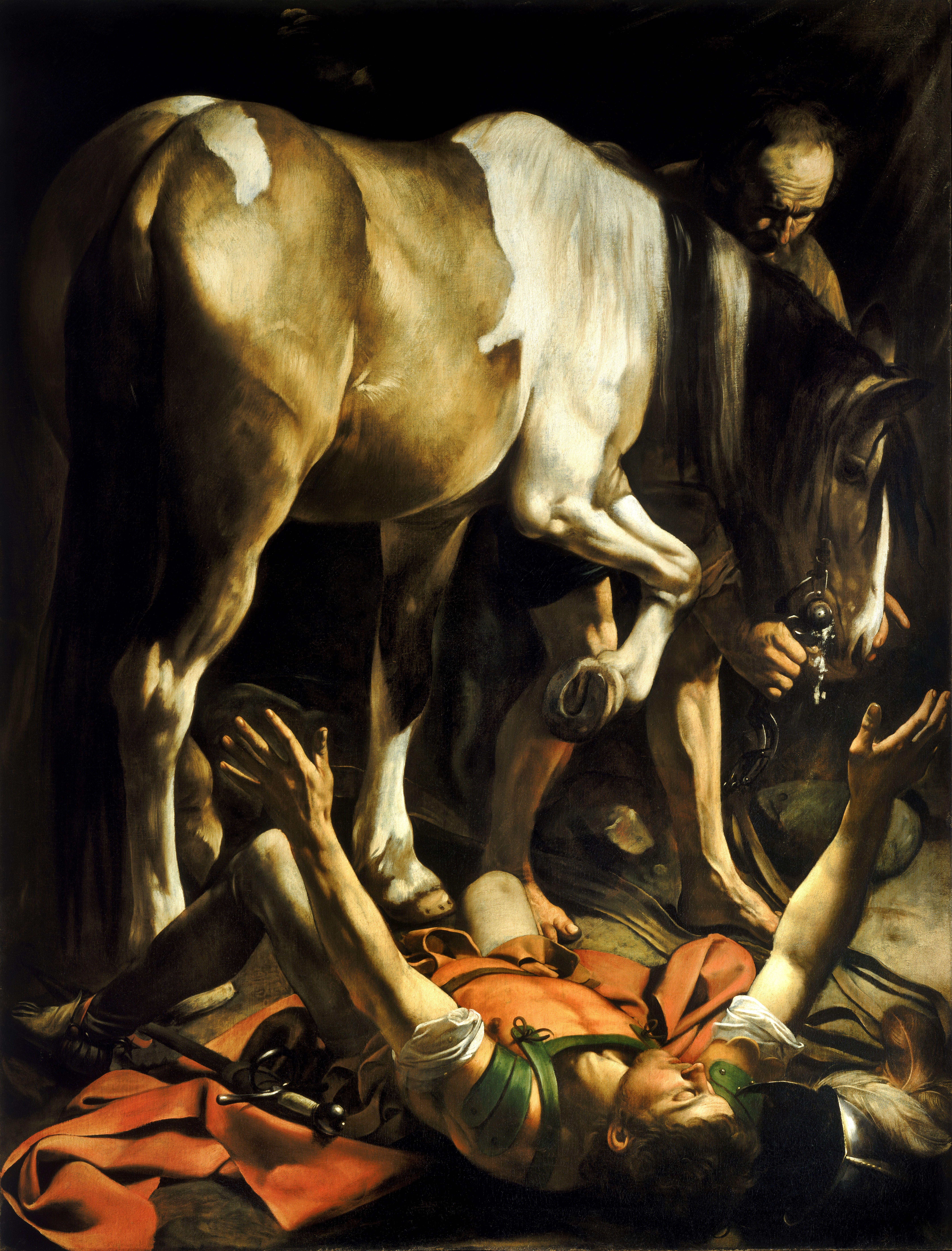
Conversion of St. Paul on the way to Damascus (1601)
Oil on Canvas
Caravaggio
In the Saint Maria Del Poplo in Rome
One of two paintings
Shows Saul whose job was to persecute christians and he was on the road to Damascus when he was blinded by light and heard a voice which was the voice of Christ and said to him Saul why did you prosecute me?
Saul was blinded for three days
Tenebroso
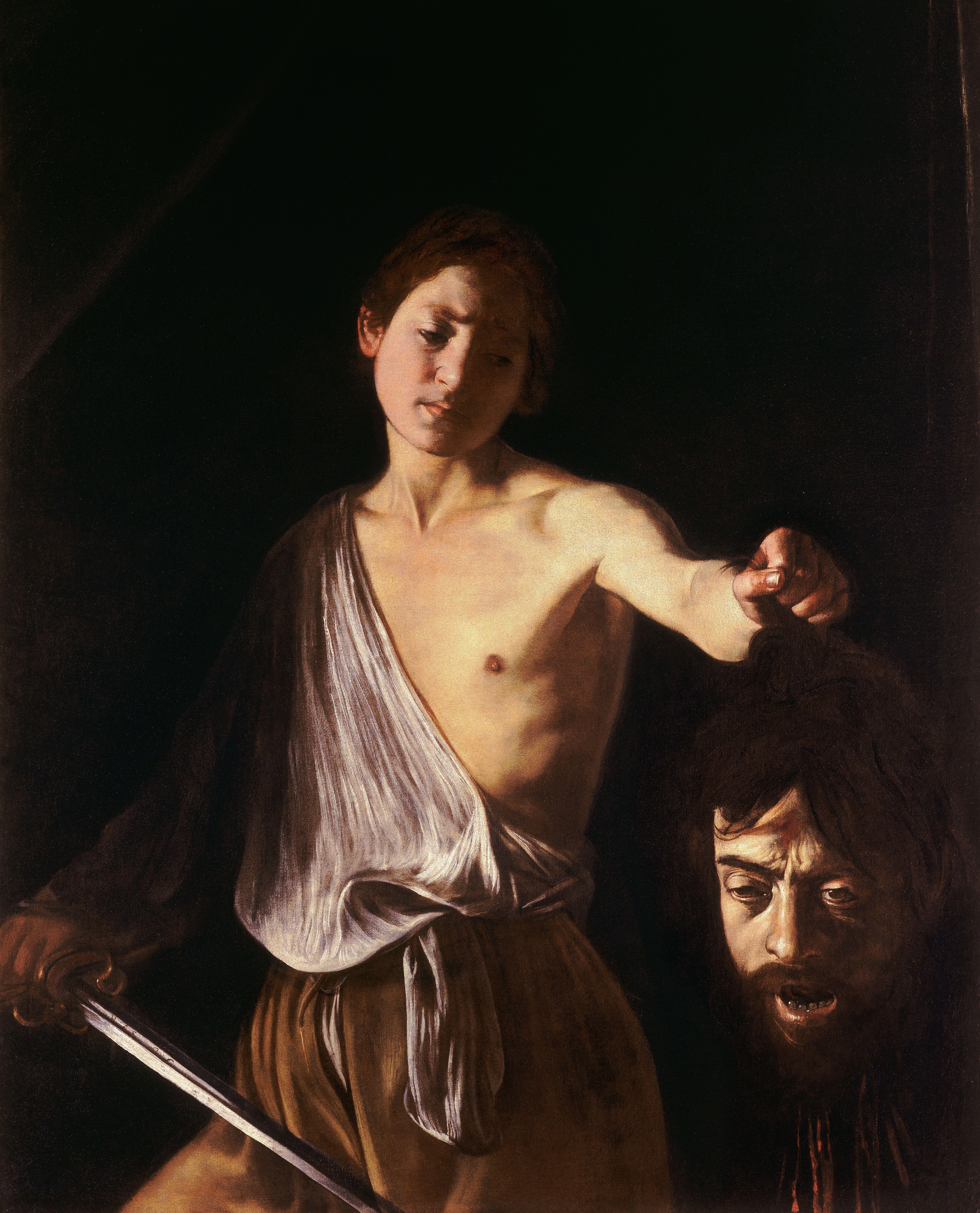
David with the Head of Goliath (c. 1610)
Caravaggio
Depicts David holding Goliath's head,
Some scholars suggest the head is a self-portrait of Caravaggio and David a younger version of himself.
In Caravaggio's work, David assumes the pose traditional for allegories of Justice, with a sword in the right hand but with scales instead of the head in the left.
It depicts the moment of victory and reflection
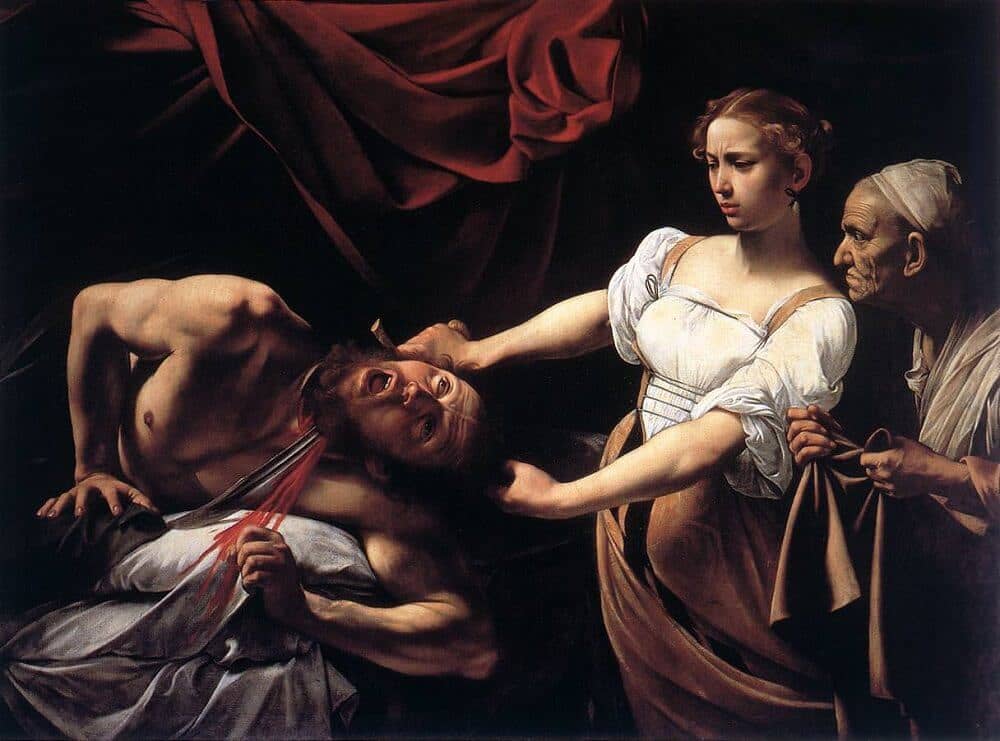
Judith Beheading Holofernes (c. 1599- 1601)
Caravaggio
Biblical story of Judith, who saved her people by seducing and beheading the Assyrian general Holofernes
Judith, young, beautiful, looks physically weak, and draws back distastefully as she seizes Holofernes's hair and cleaves through his neck with his own sword.
Holofernes, on his bed, powerful but drunk, nude, and bellowing helplessly, has frozen in the futile struggle of his last instant of consciousness.
The servant doesn't look to be doing anything and just looking as her mistress does everything
Holofernes seems to be trying to push up and trying to get out of this situation.
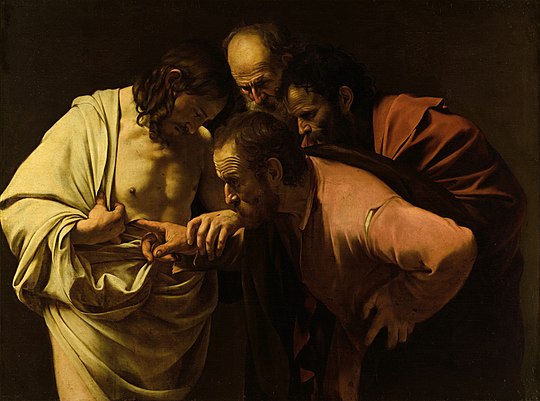
The Incredulity of St. Thomas (1601- 1602)
Oil on Canvas
Caravaggio
The focus is on Saint Thomas's right hand, firmly guided by Christ's, as the stolid doubter carefully prods the wound with his index finger.
Tellingly, the hands of the other two apostles are concealed, although their curiosity is undisguised and scarcely less restrained than Thomas's.
All three apostles are portrayed as rustic materialists without imagination or tact.
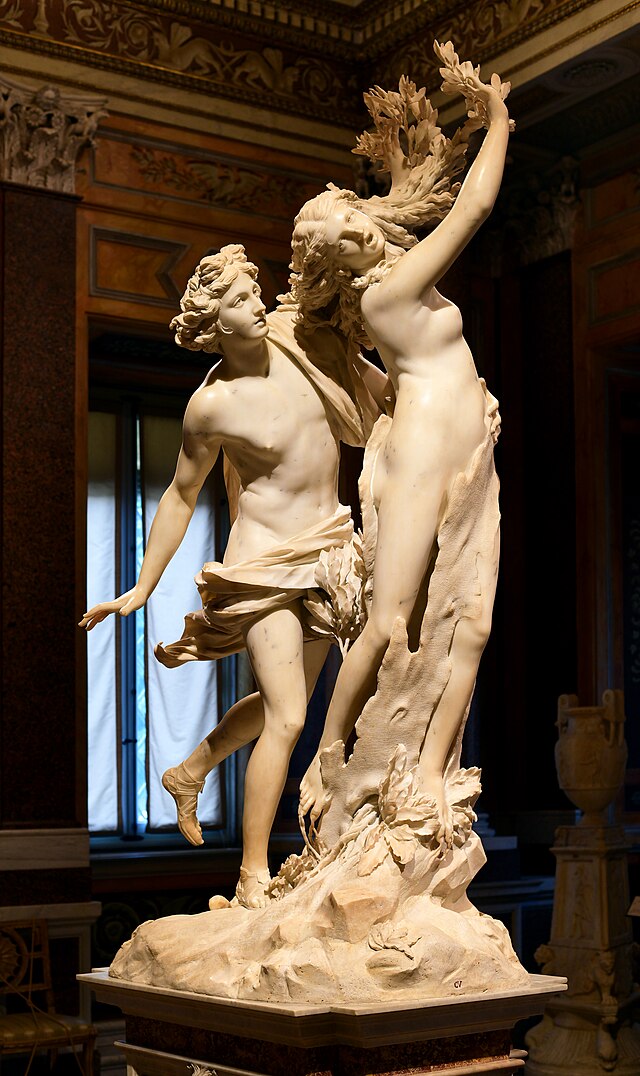
Apollo & Daphne (1622-25)
Bernini
Originally in Marble but over time it was restored with Metal
First Major commission
Stars Apollo insults Eros and he takes his revenge
Eri makes two arrows, one from gold and another from lead. He pierces Apollo with the golden one which makes him fall in love with Daphne
Daphne is pierces with the lead arrow which makes her repulsed by Apollo
Daphne ask her father Ladon to help her escape and he intervenes so the moment Apollo catches up to her she will turn into a Laurel tree
This is the moment Apollo catches up to Daphnne and she begins to transform into that tree. - Sculpting at the highlight of the action
Looks unstable, not balanced
Daphne's face is both an expression of horror and a kind of blankness
Laurel is symbolic because of laurel crowns a sign of victory
Apollo says since you can never be my bride , my tree at least you shall be
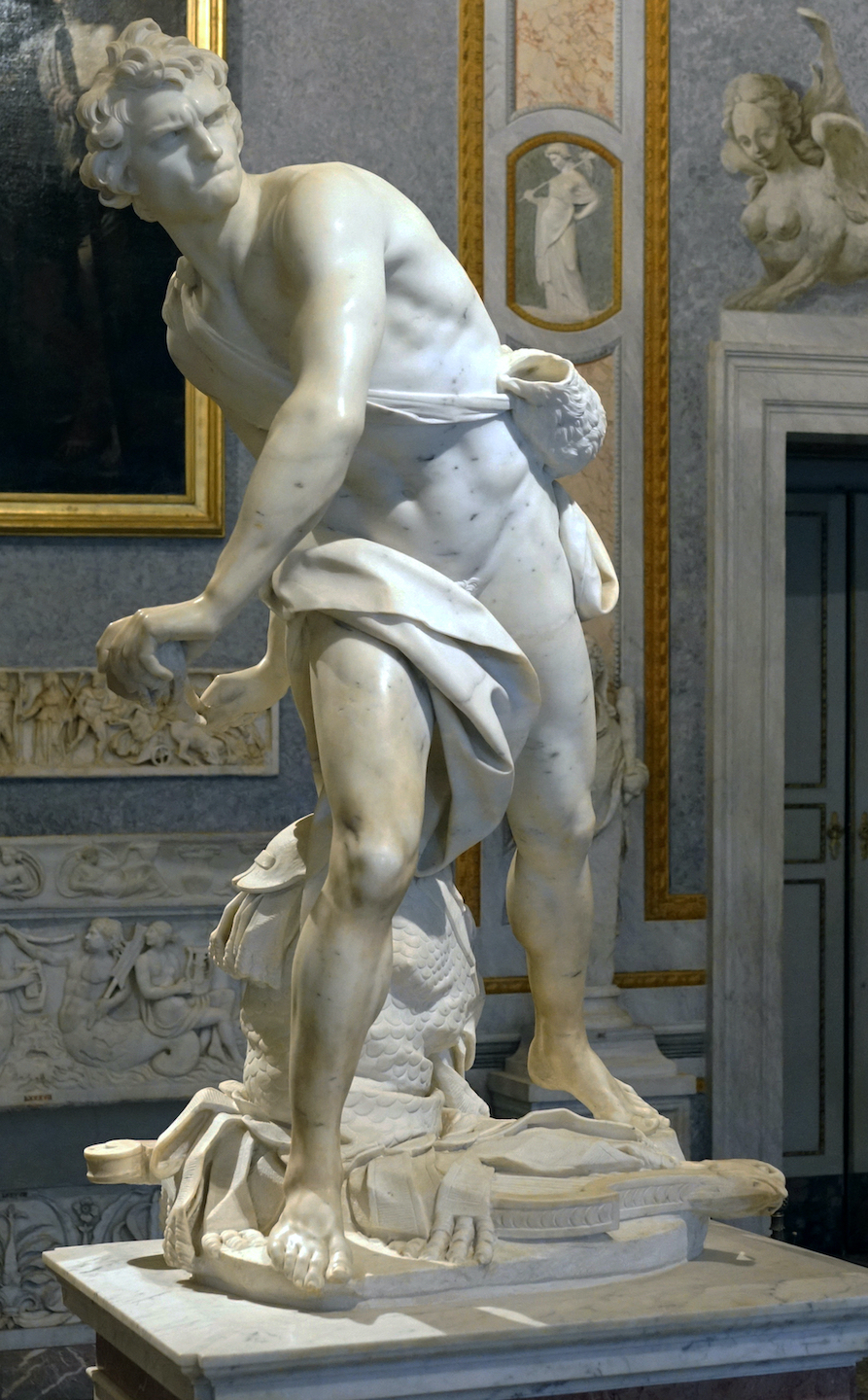
Bernini’s David (1623-24)
Bernini
Biting his lower lip brows are furrowed
Made for cardinal Borghese
Story comes from the old testament: A young man who will become King David
Moment where David is about to release the rock from the slingshot
Diagonal lines
Lips are pressed together which show his intense concentration
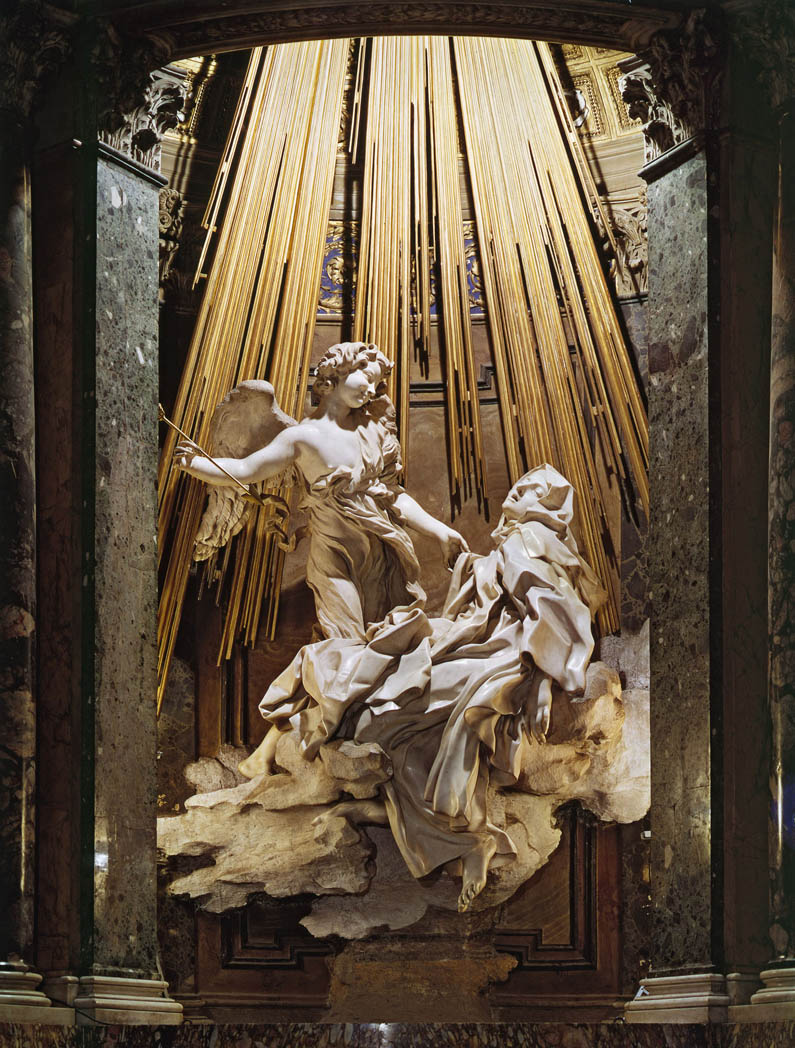
Ecstasy of Saint Teresa 1647-52
Bernini
Repeating the same colors and has contrast
Women who had mean recently made a saint and she is having a vision of an angel
The top figure is an angel a high ranking one
Shows St. Teresa having a vision of an angel
In the angels hand their seems to be a golden spear and the angel stabbed her in the heart multiple times
When the angel pulled out the spear St.Tessa felt that she was consumed by the great love of God
Seems to be enjoying the pain
Uses the Physical body and sexual symbolism to get at the spiritual experience
Angel has a sweet angelic smile and his body is graceful
On either side of the sculpture we see relief sculptures that looks like they are in theater boxes as if we were part of an audience
St.Terrsa and angel on a cloud appearing to float on air with rays of gold
Above this we see a fresco on the ceiling of the chapel which shows the Holy Spirit
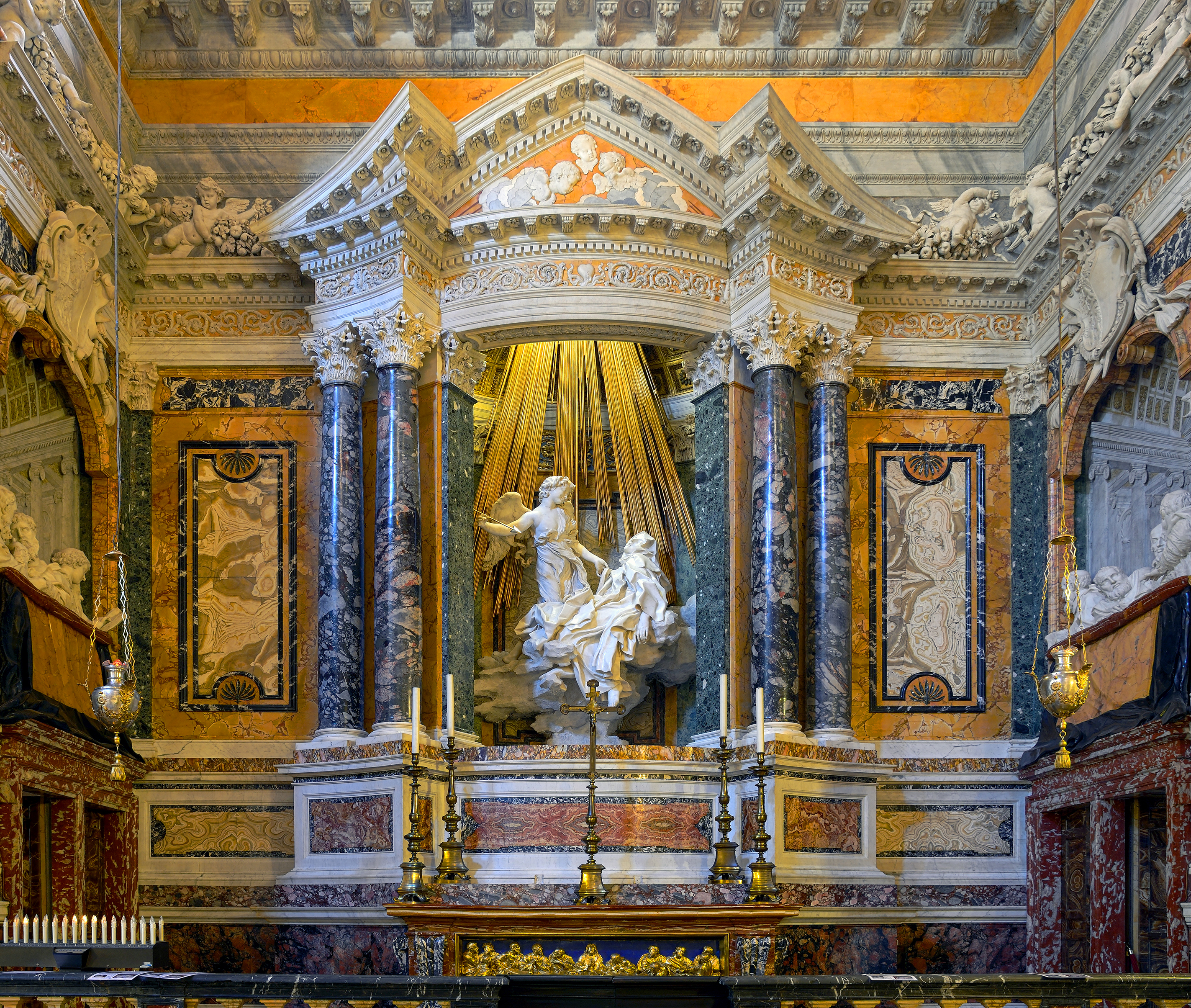
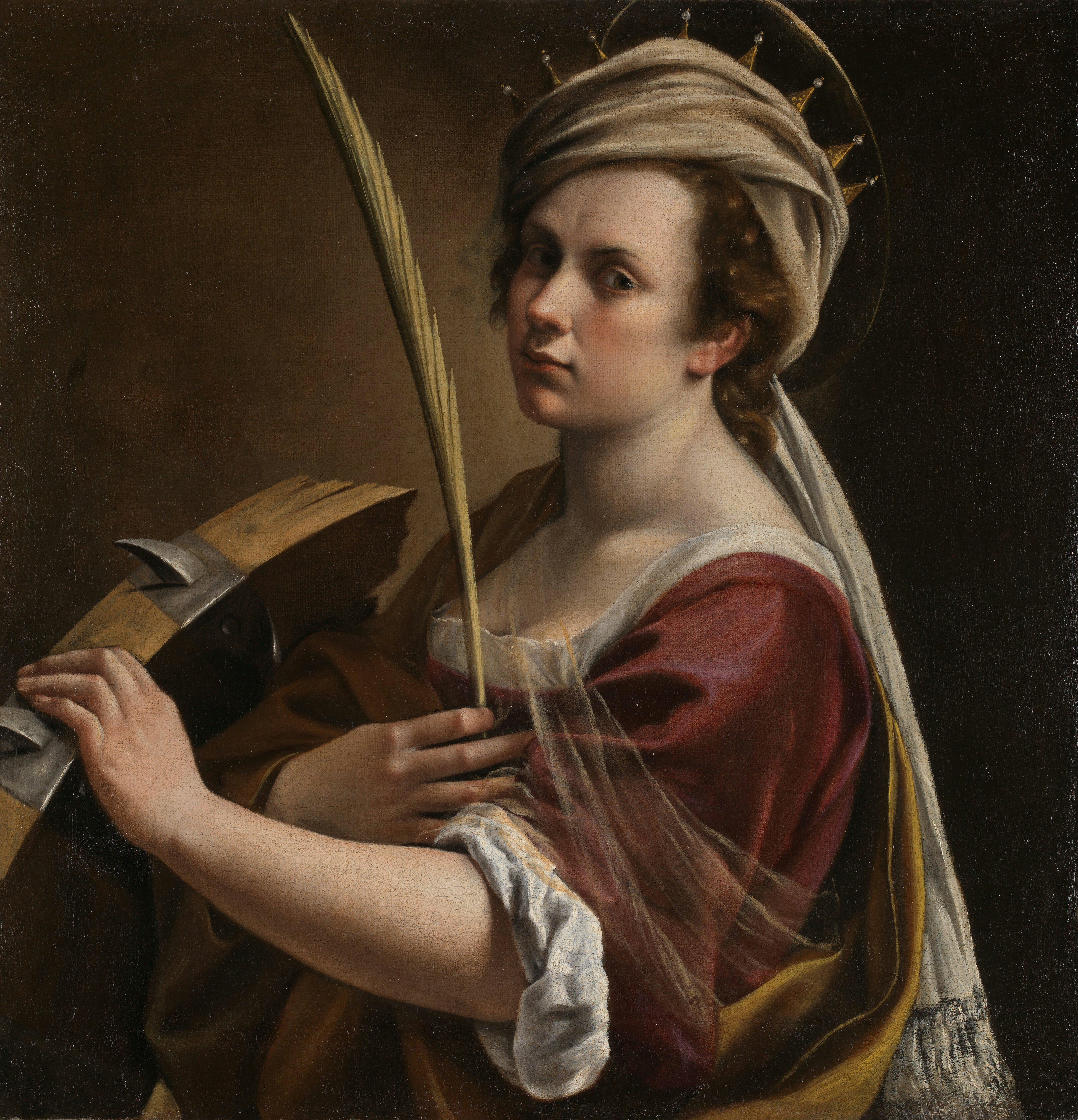
Self-portrait as Saint Catherine of Alexandria (1615-17)
Gentileschi
Saint Catherine was tortured: she was tied on a wheel with iron spikes and miraculously rescued by divine intervention
St. Catherine is seen holding the instrument of her torture
Shows a quite resilience
Shows Gentileschi promoting her own image in Florence
A little furrowed brow
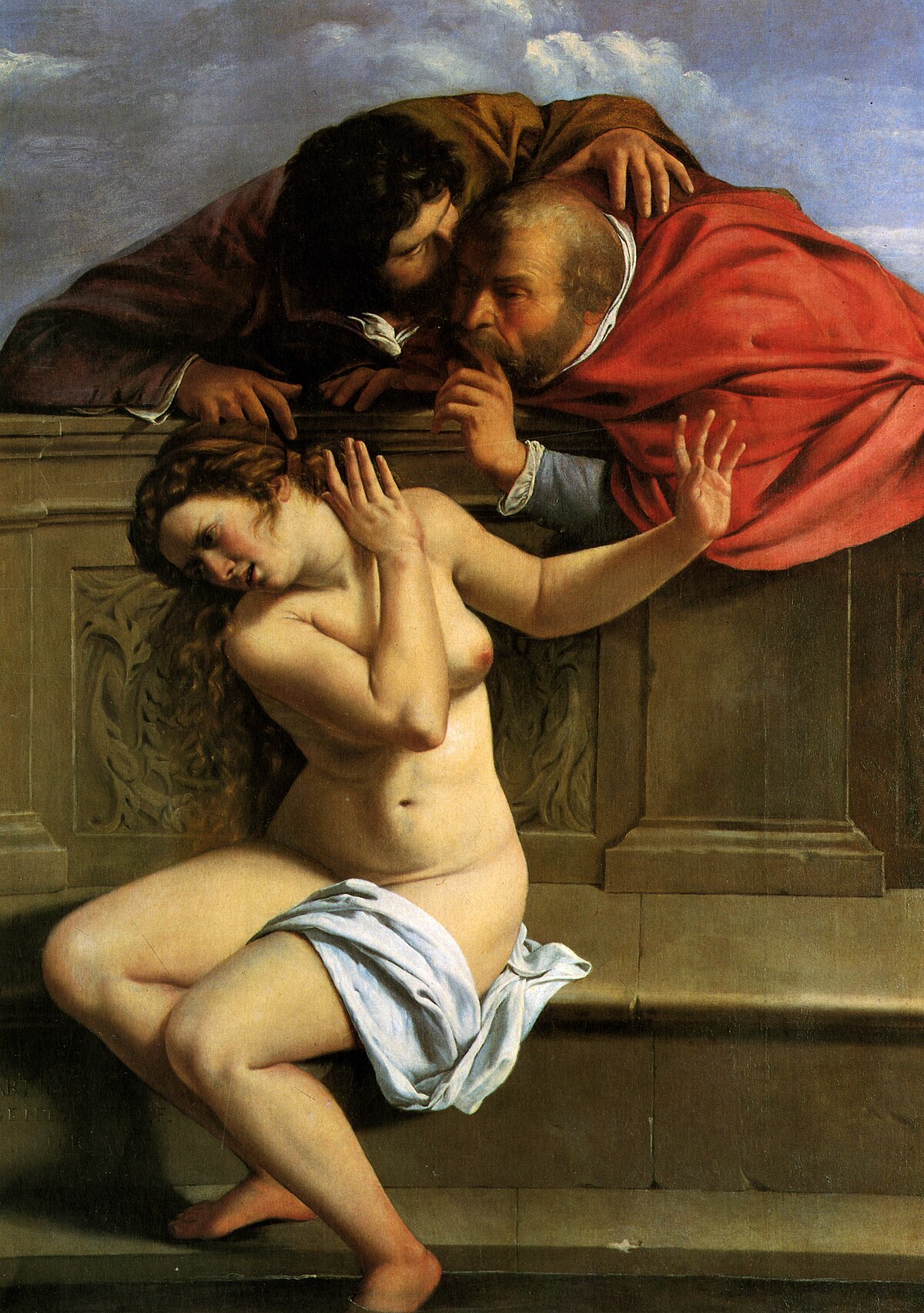
Susanna and the Elders (c. 1610)
Gentileschi
Made around the time she was SA
Old testament figure who was SA as well
She was corned into a corner by old men
Susanna is less in powered, she not in control and moving away
The men are higher up while she is lowered down trying to keep herself out of harm's way
Well-known for realistic flesh tones
Use of jewel like colors (brighter and more vibrant than male Baroque Painters)
Some paintings have been interpreted as part of her personal journey in processing trauma related to sexual assault
Baroque quality of light/shadow (TENEBRISM)

Judith Slaying Holofernes (c. 1620)
Gentileschi
Reclaiming her life
10 years after her SA
Judith and her handmaiden kill Holofernes
Her handmaiden is directly above Holofernes
The man is not in control of his fate
Judith has broad shoulders
The handmaiden is holding down Holofernes
Holofernes hand reaching out and trying to get the handmaiden off of him
Judith and the handmaiden look to be on the same level of Holofernes
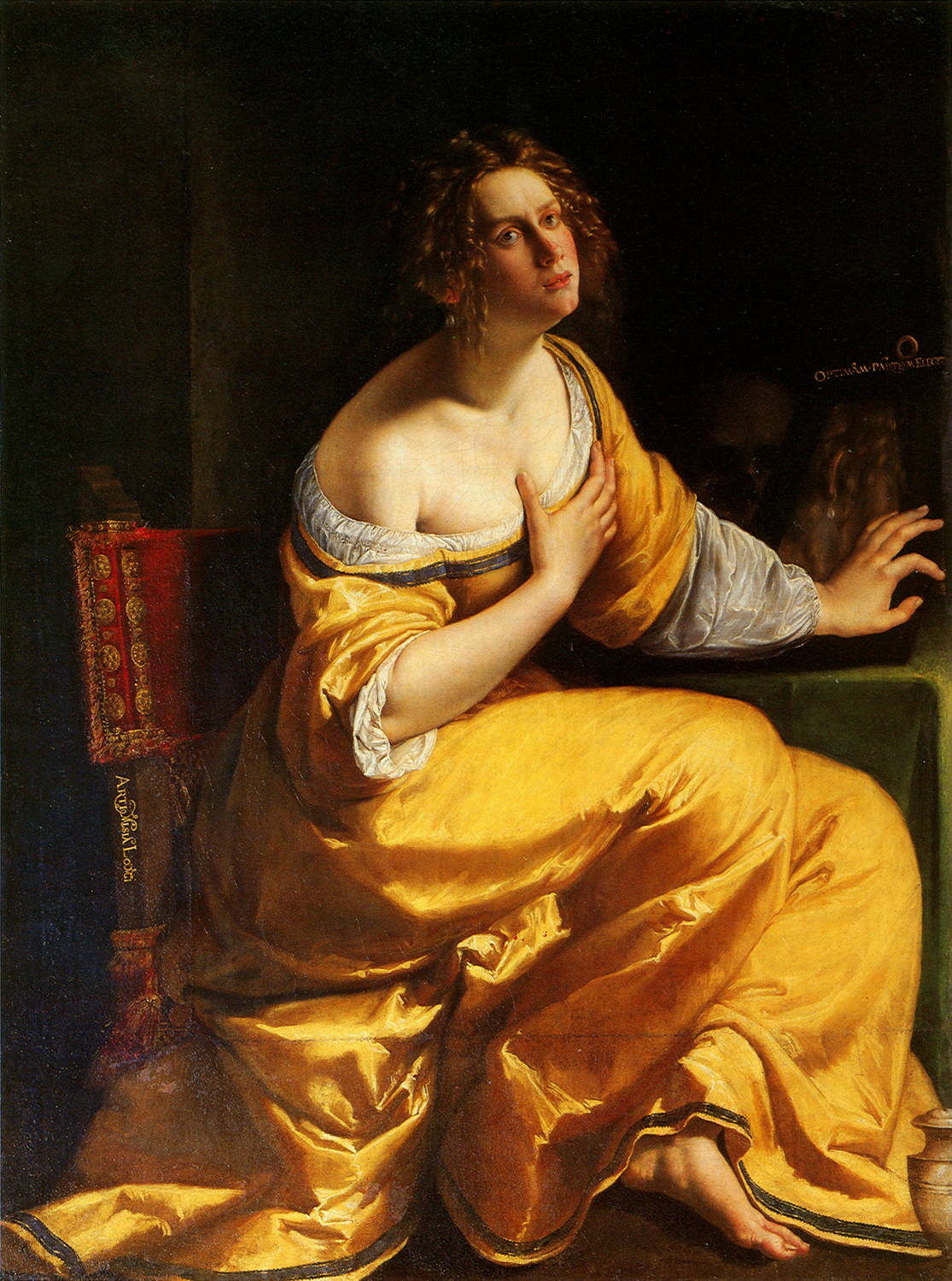
Penitent Magdalene (c. 1615-1616)
Gentileschi
One Of Jesus follows unofficially
She was a prostitute before she meant Jesus
There could have been a romance between her and Jesus
Contemporary of Italian Women to make people think about people in their own society that weren't really expected because Magdalene was considered an outcast
Mary Magdalene turning away from a life of sin to become one of Jesus’ followers.
She very crunched up
Felling of uncertain and stressed = Posture is closed off
Suggest it could represent a sense of shame
She took care of Jesus after her death
TENEBRISM
Barefoot is supposed to represent that she is a servant of Jesus
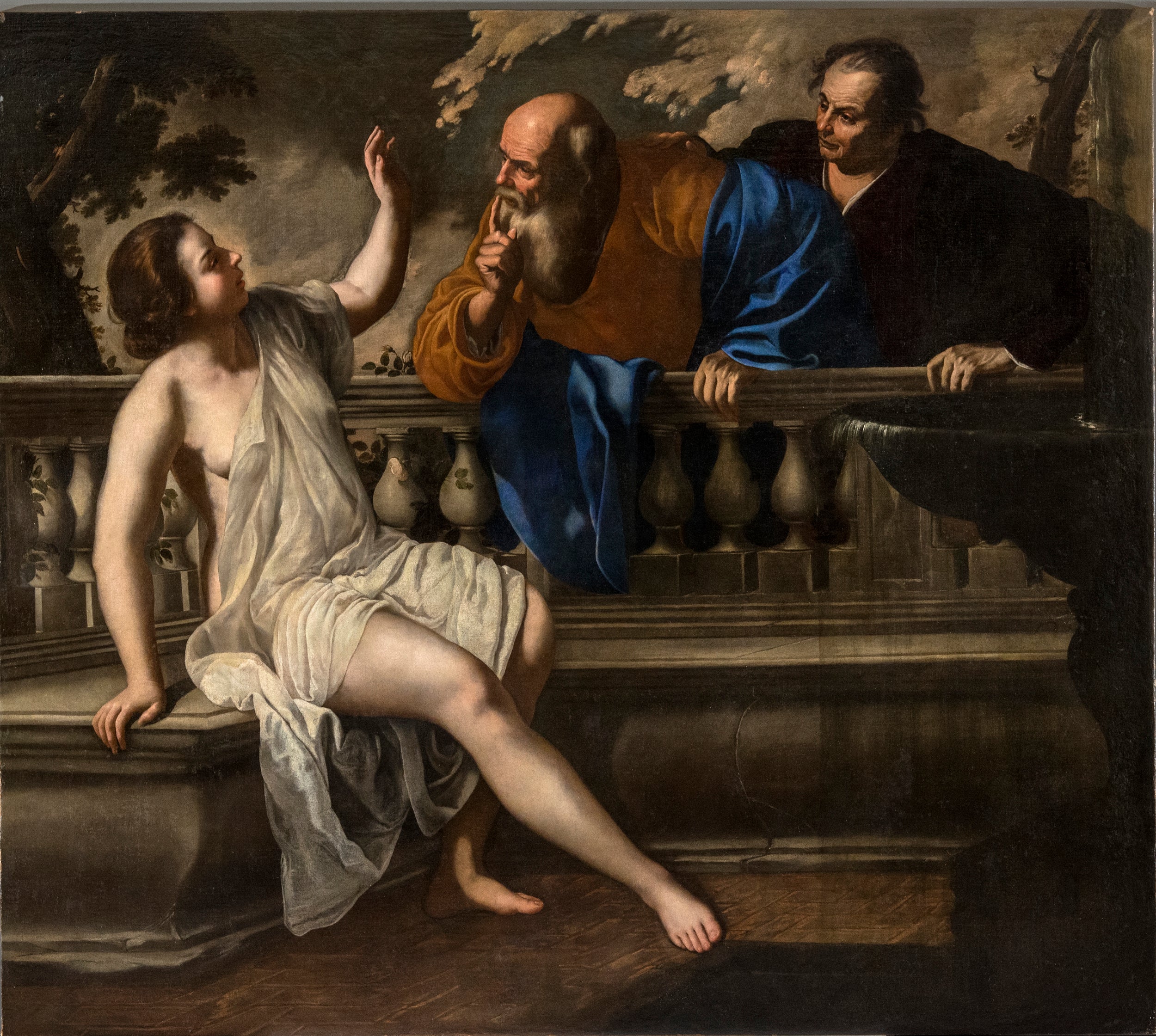
Susanna and the Elders (c. 1652)
Gentileschi
seems to be unfinished
Leading out of the Baroque tendenes
Landscape format she's no longer below the men but on the same level
She body is more covered up and she looks in control of herself/ she's not in a corner
Less vibrant
Before the advances actually happen
Trying to change the narrative
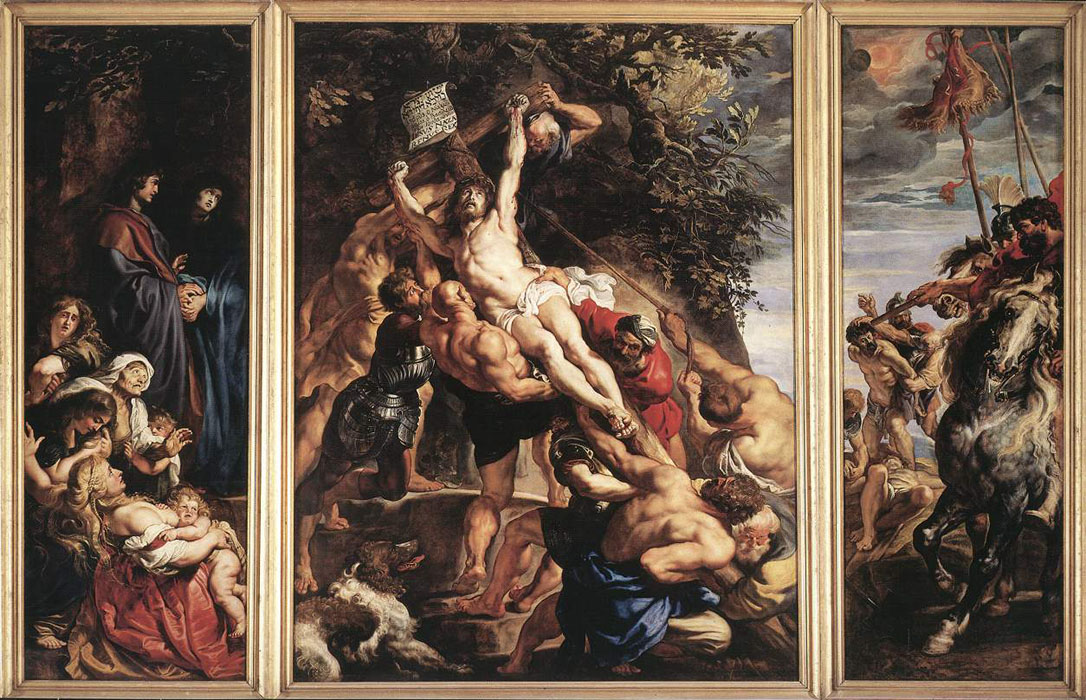
The Elevation of the Cross (1611)
Rubens
Well known for flushy, curve figures
Jesus is still alive
Warm undertone and glow
Triptych
Being raised up on the cross by men who are very muscular almost looking like circus strong men which can suggest the brutality of these figures that all they are are brute force
Moment of the sacrifice/ moment that is critical for the Eucharist/ moment where Christ sheds his blood for mankind
Was originally in a church but it got destroyed and in that church at the top of the steps it had an image of God which could explain why he was looking up
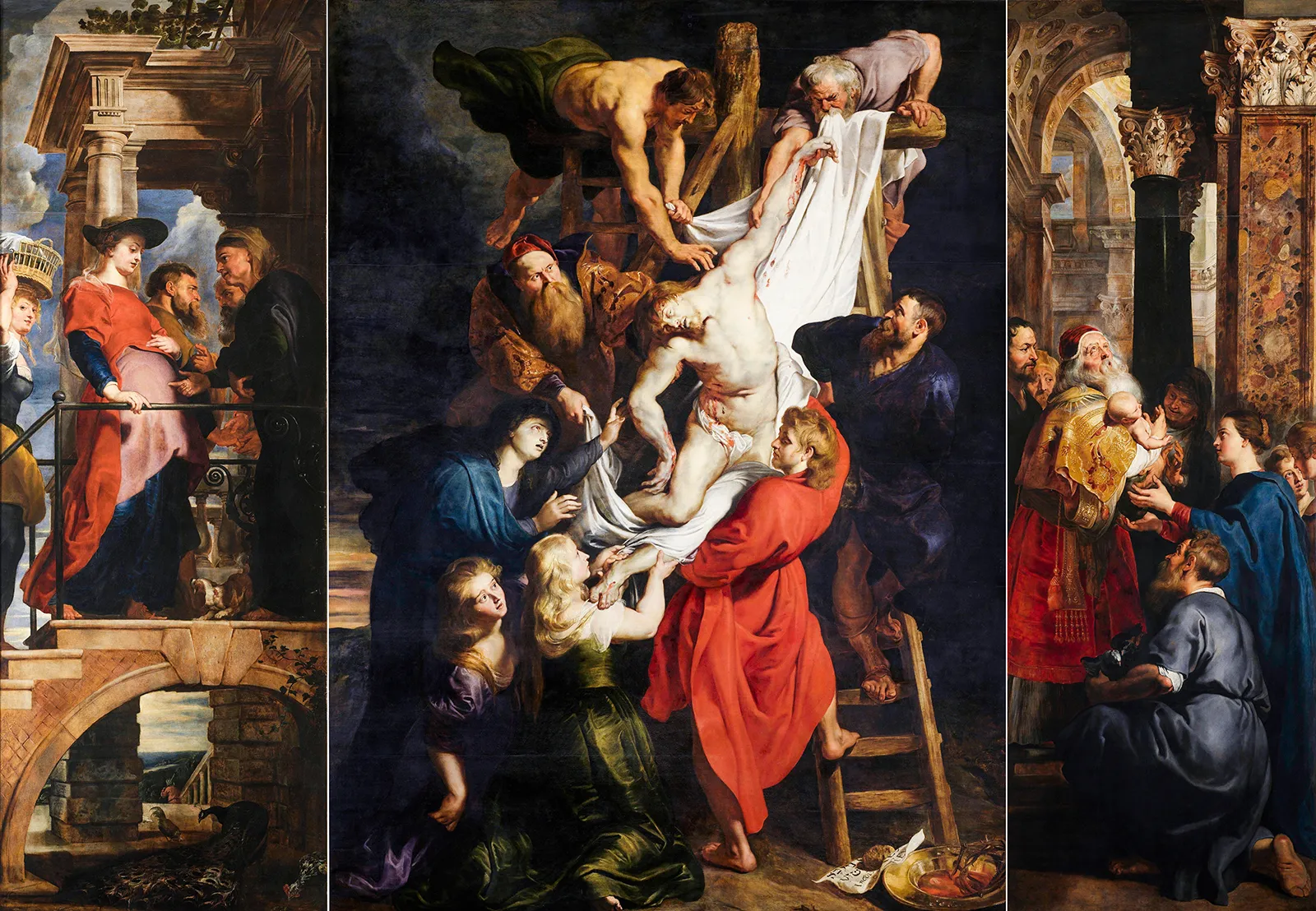
The Descent from the Cross (1612)
Rubens
Flushy
Lots of details
Cool tones more grey and blues which connect to death
Magdalence was most likely shown in this near the bottom helping to bring christ off the cross
Christ body is being lowered as gently as possible
Triptych
You can tell the limpness of the body and its weight
A man at the top is seen clenching the sheet holding Christ's corpse behind his teeth so he can liberate his arm to hold up Christ - you can see the blood in his cheeks, forehead.
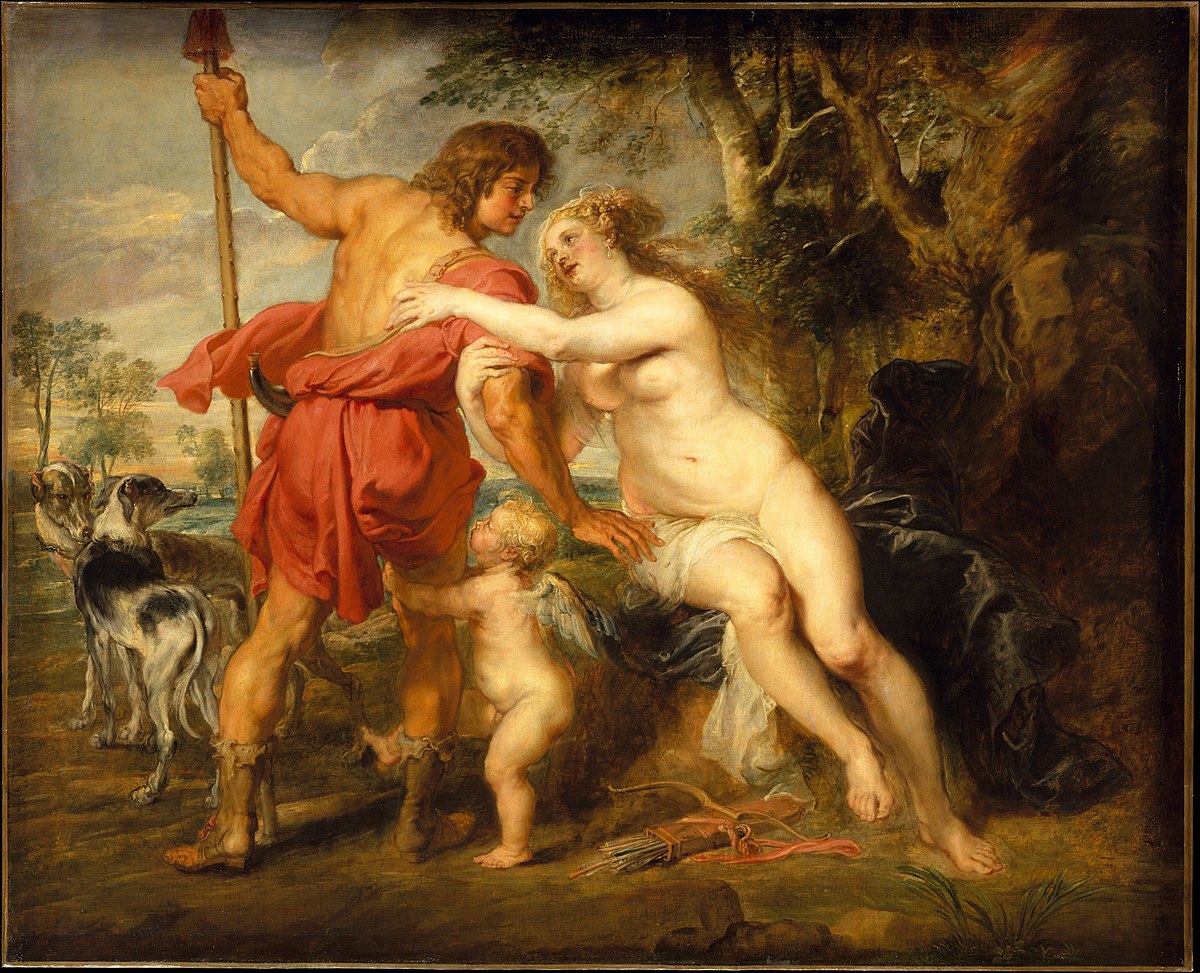
Venus and Adonis (c. 1635)
Rubens
Flushy nudes
Looking back at the renaissance and making them his own
Greek mythology tells the story of Venus, the goddess of Love; of her unrequited love; and of her attempted seduction of Adonis,who would rather go hunting.
Adonis has a spare in his hand showing his a hunter
Hes twisting away from her
Dog in the back “hunting dogs”
A lot of arrows on the ground which represent hunting and cupids arrows
Cupid is shown holding Adonis leg not wanting him to go
Venus is seen to be begging him to stay and has a grip on him
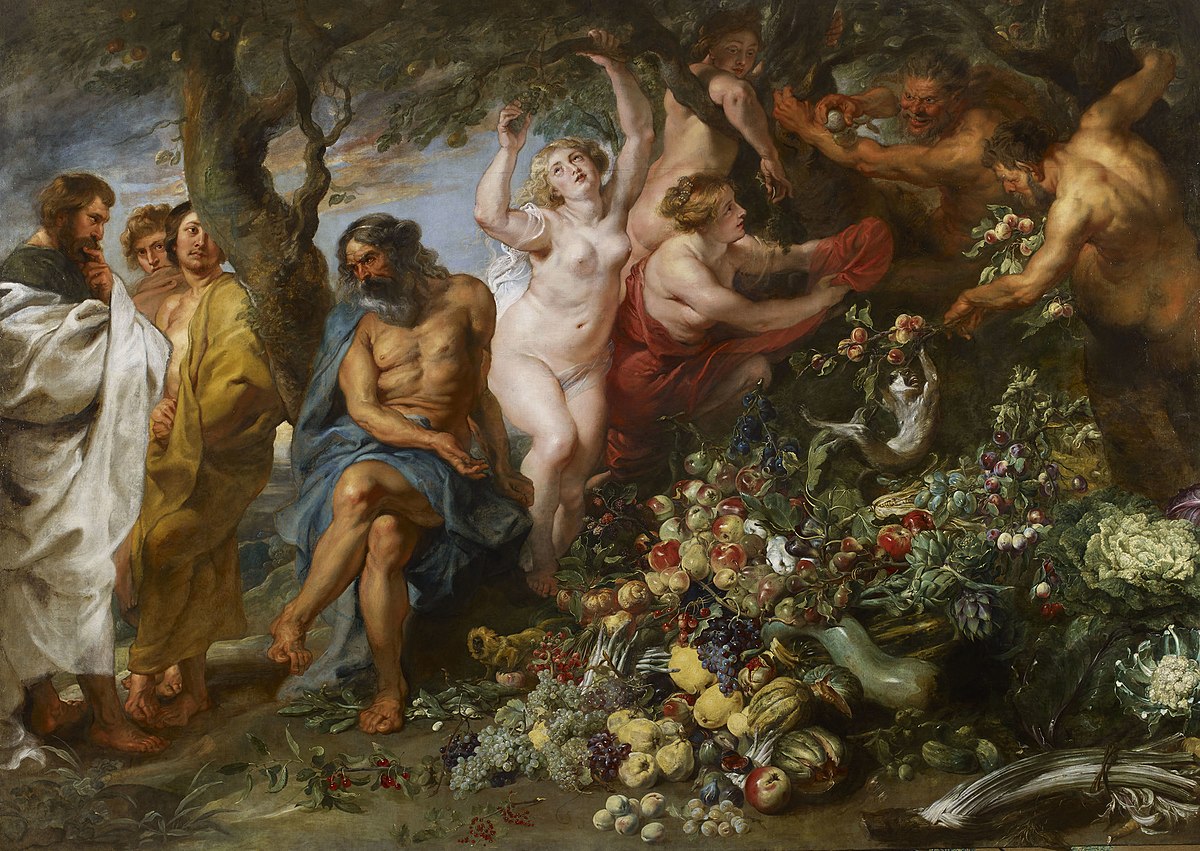
Pythagorus advocating Vegetarianism (1618- 1630)
Rubens
Pythagoras is a methanation
Lots of Greek/Roman philosophy's advocated for vegetarianism
Advocated for vegetarianism diet because raising animals meant that you have to feed them vegetables so why go through the extra level
Back in those days the beauty standard was being pale because it represented that you were important and wealthy while if you have a darker skin tone is represents you worked in the fields
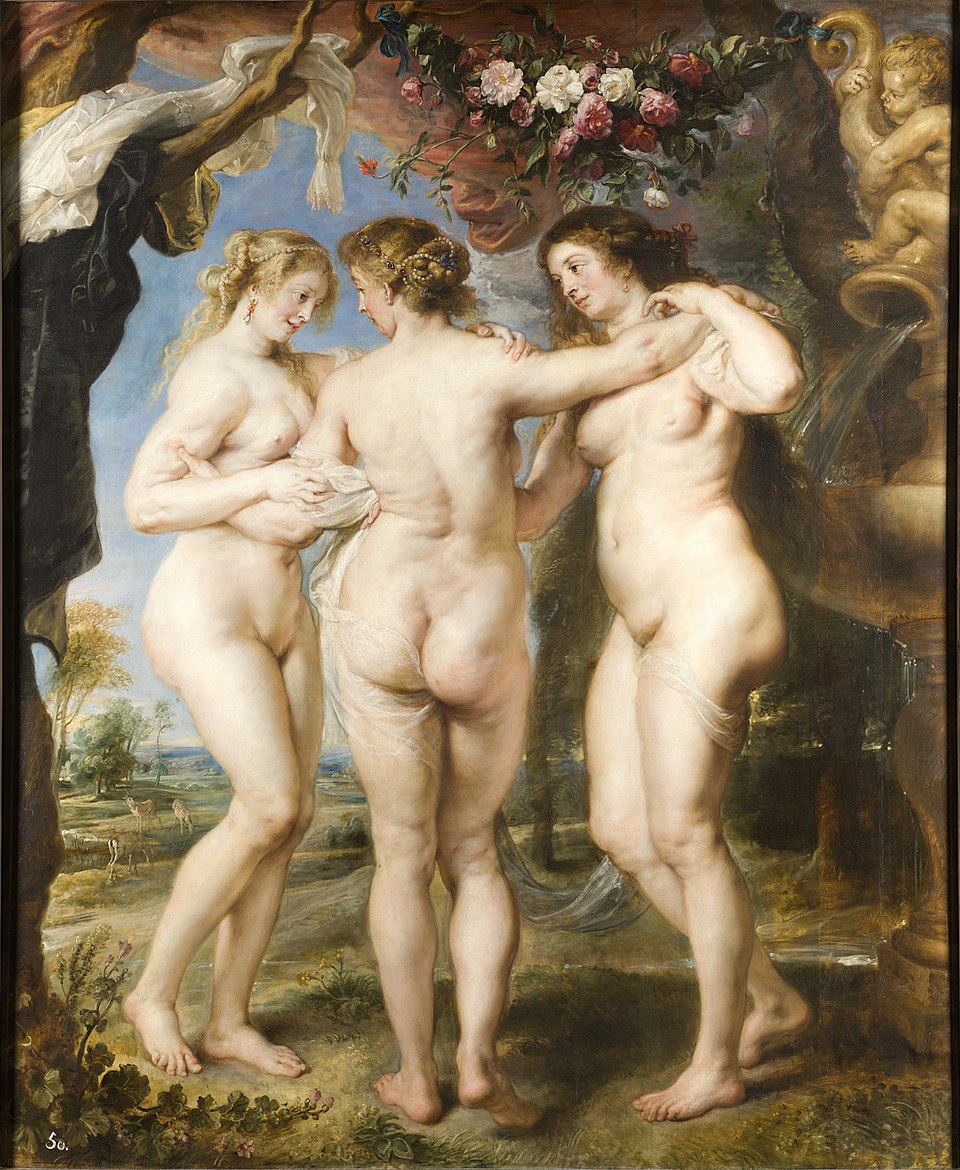
The Three Graces (1635)
Rubens
Three very curvy women
Rubenesque nude
Symbols of fertility - the water coming out of the foundation on the right = new growth and purity, flowers roses = beauty,
Are from Greek/Roman societies
Tiny amount of fabric but its not covering theme
Arms are connecting to each other

Self-Portrait from 1660
Rembrandt van Rijn
Very intimate
Painting every wrinkle, skin tone looking at every imperfection
Skin tone colors: green, yellow, gray, red, brown
The face itself was very thick and the rest is very loosely brushed
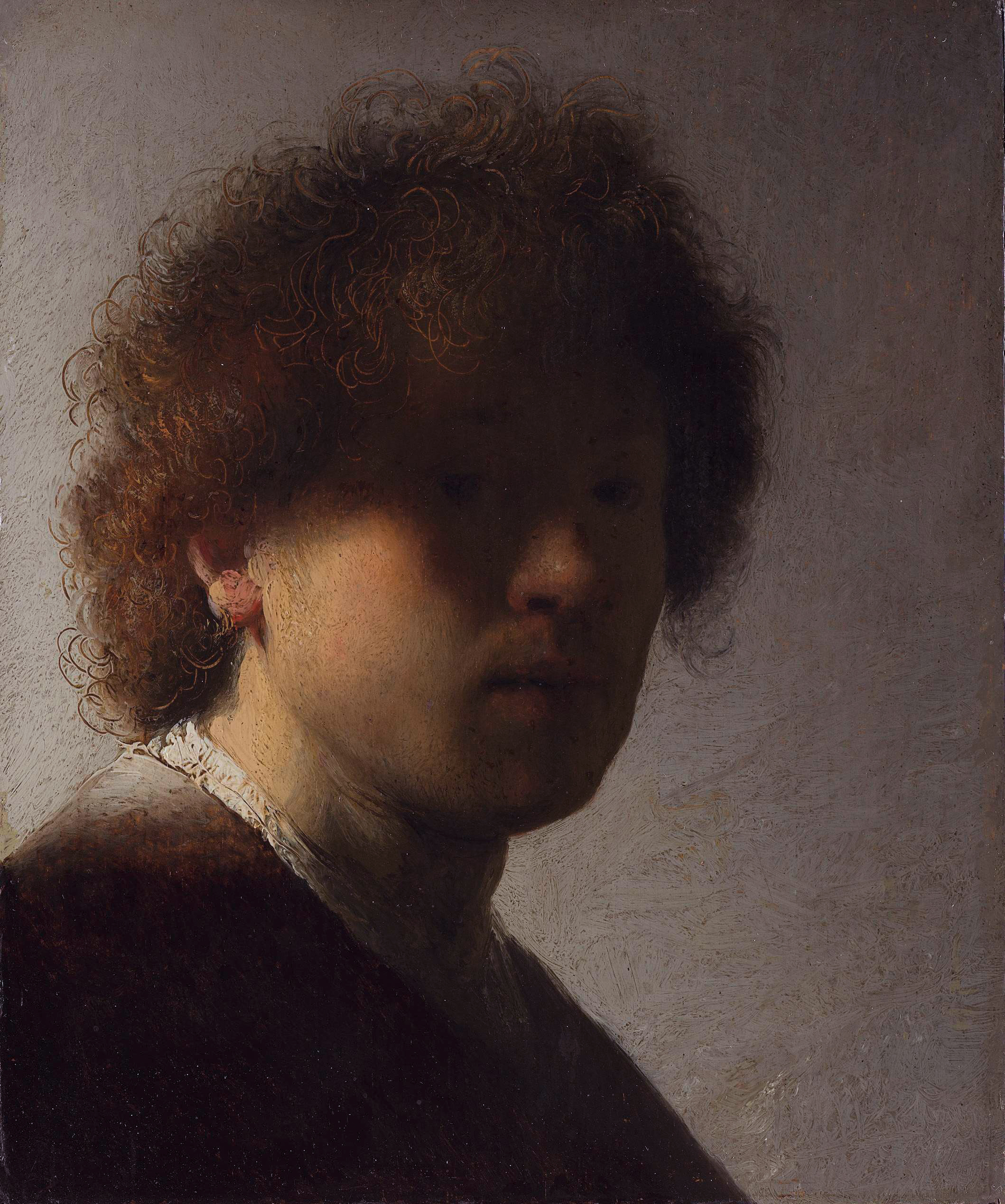
Self-Portrait (1628- 29) -
Rembrandt van Rijn
Oil on Oak Panel (7x8 inches)
His eyes are still visible even though there are very dark visuals in this painting
A little bit of shine on the nose
The face itself was very thick

Man in a Turban (1632)
Rembrandt van Rijn
Dutch person wearing a turban for costume wear
Tenebrism movements
Dutch connection to other countries
Showed wealth/ statues
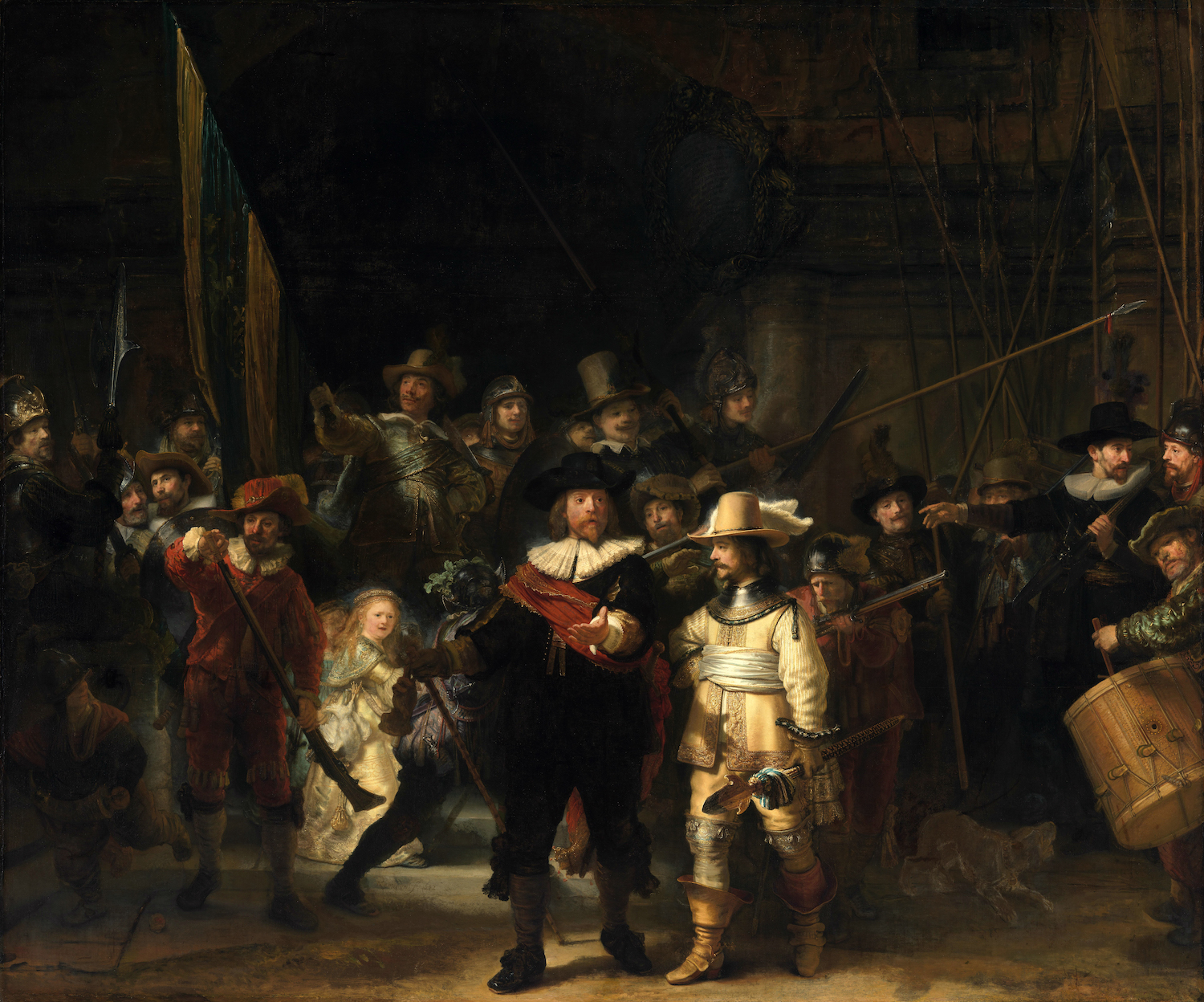
The night watch (1642)
Rembrandt van Rijn
- Oil on Canvas
Painting of one of the militia groups in Amsterdam
Militia groups were supposed to defend the city but by the time Rembrandt paints this they were largely ceremonial
Symbolized civic pride
Painting was very specific to the Dutch republic
Looking at elite citizens in Amsterdam
Takes up majority of the wall
They seem to be in the act of coalescing around an action
Captain is giving an order for the militia to gather and move forward his giving the order to the lieutenant
There is a dog barking, someone playing the drums
There is a girl striding forward that can be looked as a mascot in her dress she has a dead chicken that's been hung upside down from her belt the claws very prominent which refers to the name of the militia group
Was not called the Nightwatch originally but named after the militia its representing
Lots of diagonals angles
Very lifelike
Painting is so big that the figures are life sized

Bathsheba at her Bath (1654)
Rembrandt van Rijn
Old testament story
More forced on Jewish Tribes
King David sees her bathing from his terrence and is struck by her beauty and summons her though she is a wife of a general
They begin an affair which ends in tragedy with Uriah being sent by David into battle to certain Death
David and Bathsheba end up having a still born child
She looks as if shes faceing a conundrum because she will be cheating on her husband
There looks to be a bit of sadness and some interest in the illicit as well
She holds a letter in her hand a letter from King David summoning Basheba
Chiaroscuro
The focal point is her face showing a mix of emotions
Moment before the love affair
Tied to a famous song hallelujah
Has a stark contrast necklace
Her eyes follow an diagonal angle
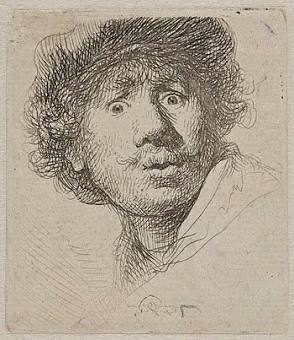
Etchings
Rembrandt
A printmaking process
A copper plate has a ground applied to it, then a drawing is made into the ground using a sharp tool
The copper plate is etched with acid and the lines drawn into the ground become lines etched into the plate
Ink is applied to the etched copper plate
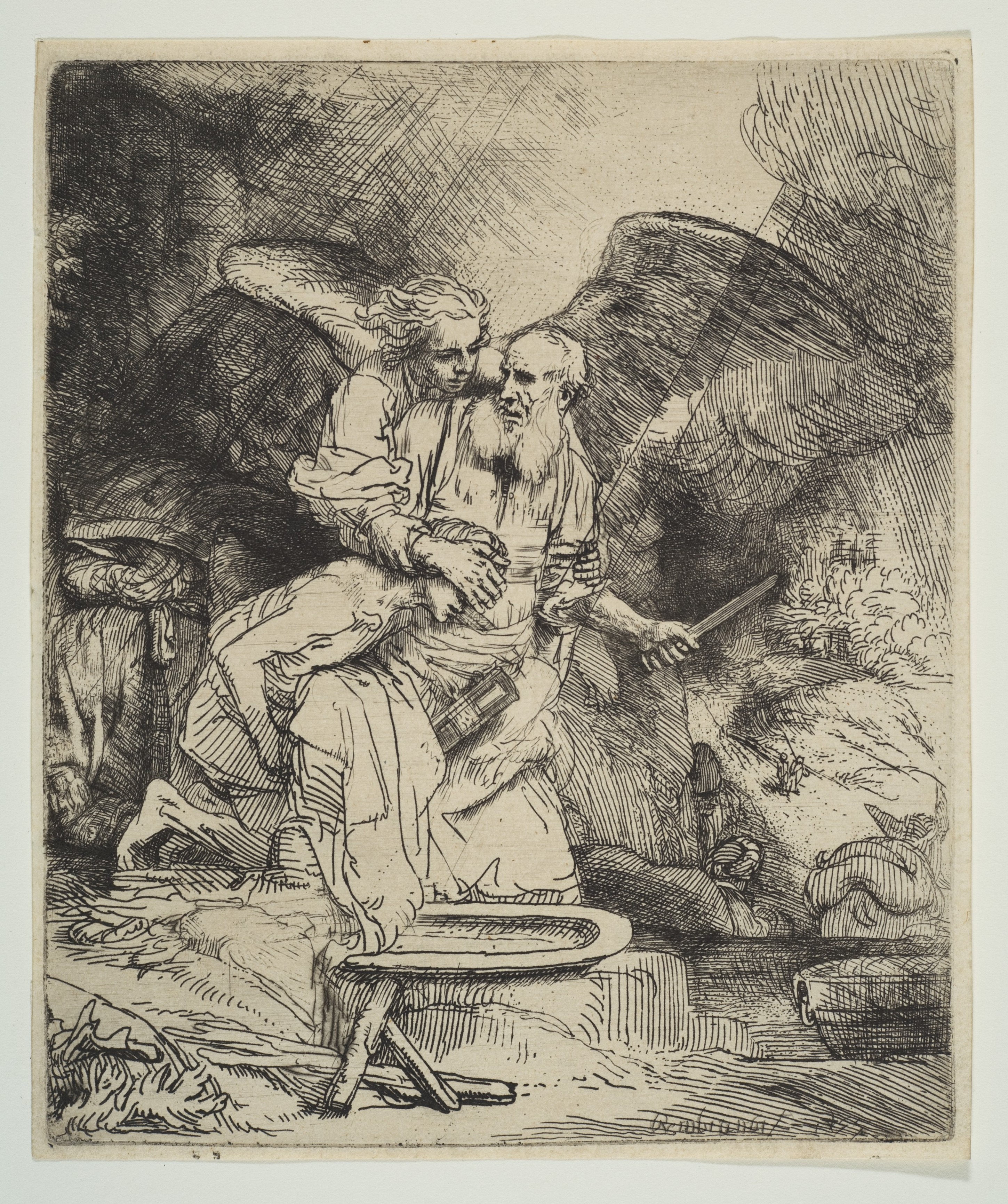
Multiple prints (“Editions”) are made from this single plat
Surprised or fear
Artwork: Abraham’s Sacrifice (1655)
Artwork: The Three Crosses (1653)
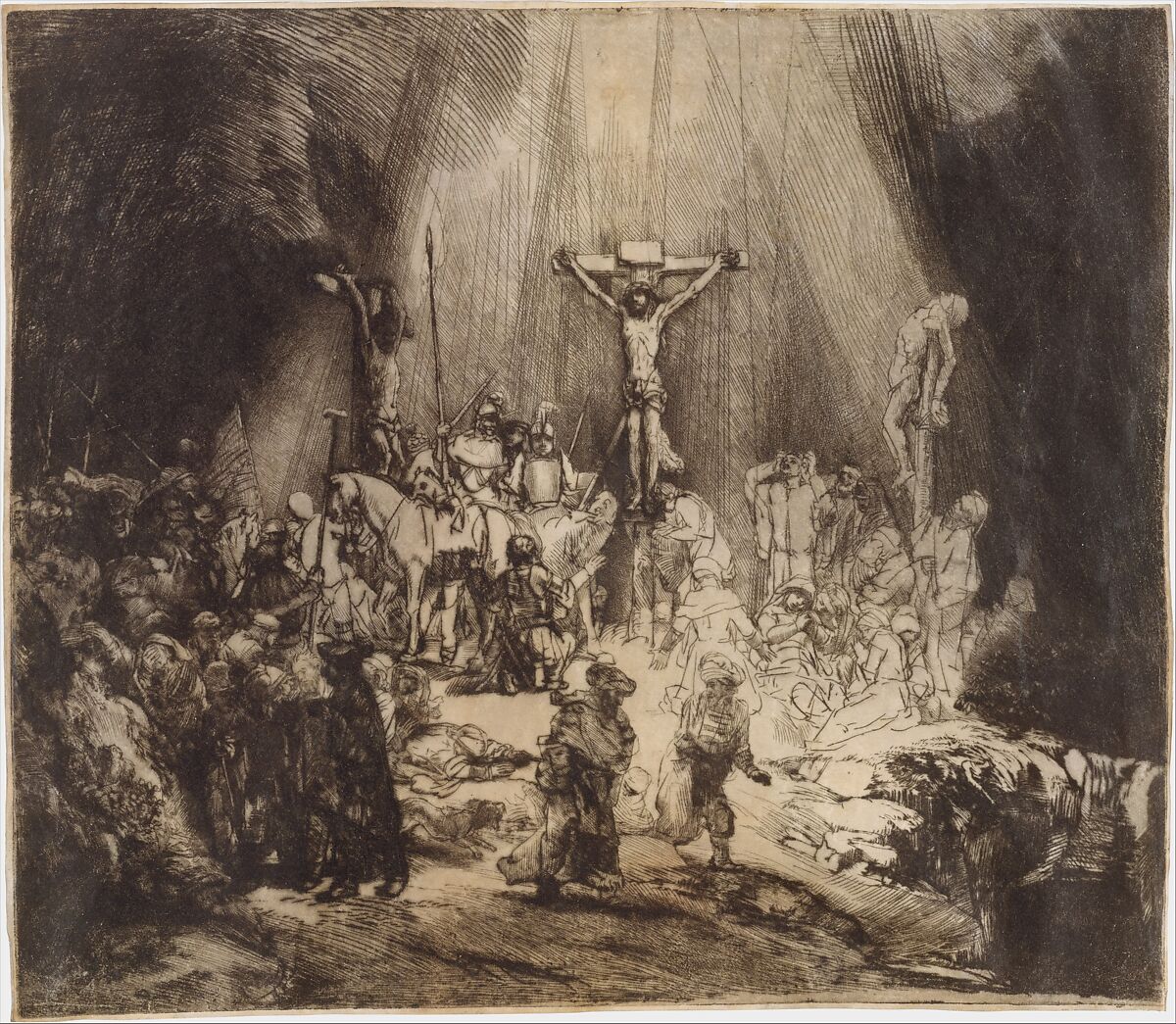

Christ in the House of Martha & Mary (c. 1654- 56)
Vermeer
Shows jesus with his female followers which was not typically shown
Showed what he invision jesus relationship was
Martha is shown the top working to prepare for his arrival and shes annoyed because her sister Mary isn't doing anything to help her
Mary is just listening to Jesus and absorbing what Jesus is saying shes sitting down
It shows the moment when Jesus responds to Martha’s complaint about Mary’s apparent neglect in helping her.
Subtle halo
His largest painting
Women are wearing very traditional dutch clothes
Jesus clothes is very renaissance

Vermeer Young Woman with a Water Jug (c. 1660- 62)
VermeerThe LIGHT is the main subject, shows a sense beauty in everyday life
Headdress: Traditional Dutch attire. Indicates Wealthy or Upper Middle-Class
Other Indicators of Wealth: Stained glass window, water pitcher is gilded with gold, heavy wool tablecloth traded from foreign country, & jewelry box
Map: Shows the Netherlands and is a reference to trade/expansion of travel
Shows the love of everyday
Finds beautiful moments in everyday life
Point of the painting is to celebrate the everyday
Women’s clothes
Protestant clothes
Linen headdress
The person in the painting Could be his wife or daughter
Voyeur
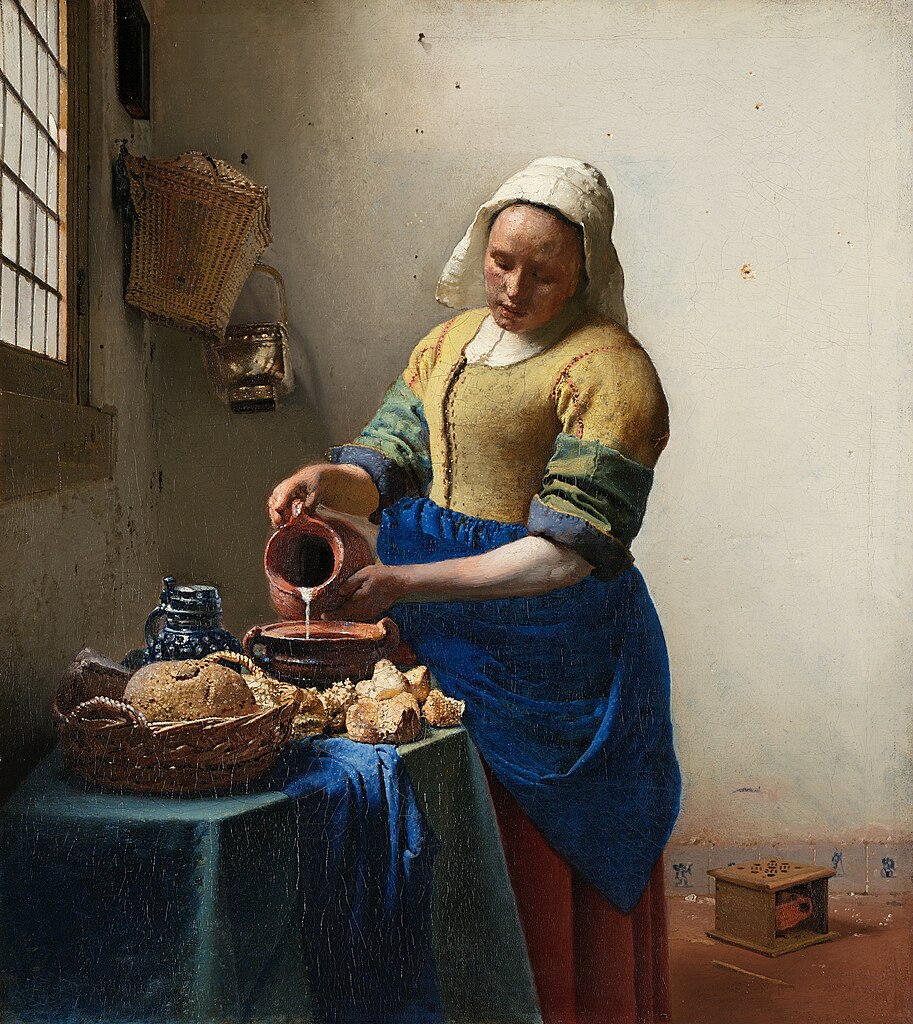
The Milkmaid (c. 1657-58)
Vermeer
Cleary looking at someone whos not wealthy or higher middle class
Same light and moment of everyday life as the Vermer Young Women
Felling of the wall is more dengy
Th goods in the picture are showing that class of the women
Her dress is more of a basic cotton and more airy, headdress is a simple head wrap
Window also doesn't have a beautiful design and is very simple
Main Vanishing Point/lines converge above WATER PITCHER
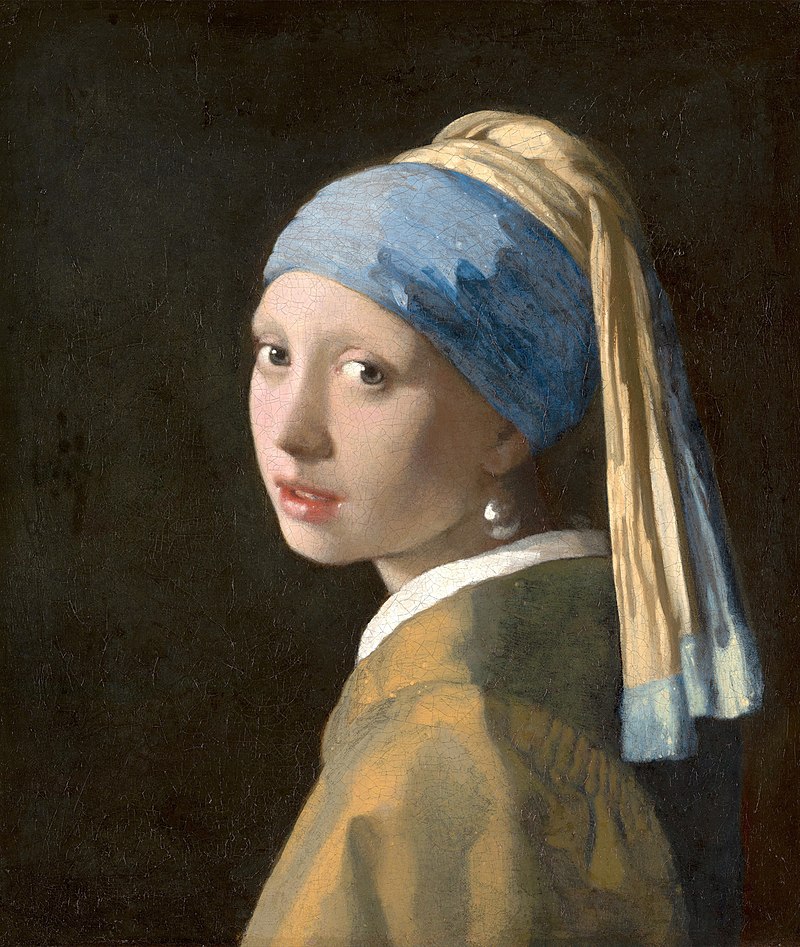
Vermeer Girl with the Pearl Earring (c. 1665)
Vermeer
Face very perfect and flat in some places
Lot of attention to her face
BACKGROUND is just black there is not environment to tell us who she is
Looking at the viewer
SHe looks over her shoulder to look at someone staring at her
Often referred to the Mono Lisa of the North
Emphasizes the worldliness of the merchant class
The pearl is not real, it was likely just a glass or tin drop varnishes to look like a peal
Speaking likeness
A person looks most natural and authentic
Person looks more life like as if they are breathing
Example portrait of king Louis XIV